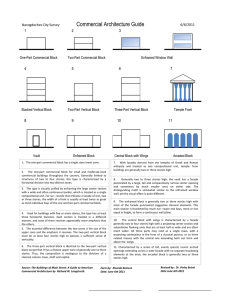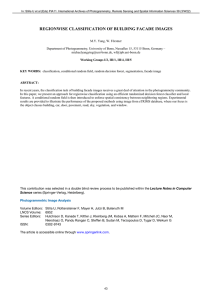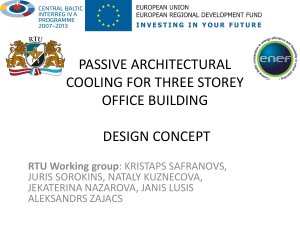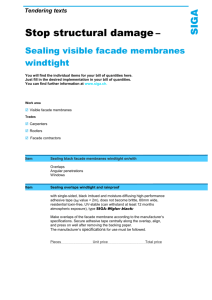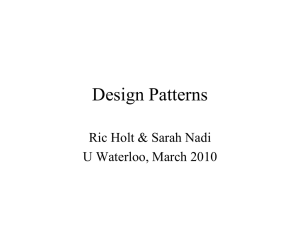GRAMMAR SUPPORTED FACADE RECONSTRUCTION FROM MOBILE LIDAR MAPPING
advertisement
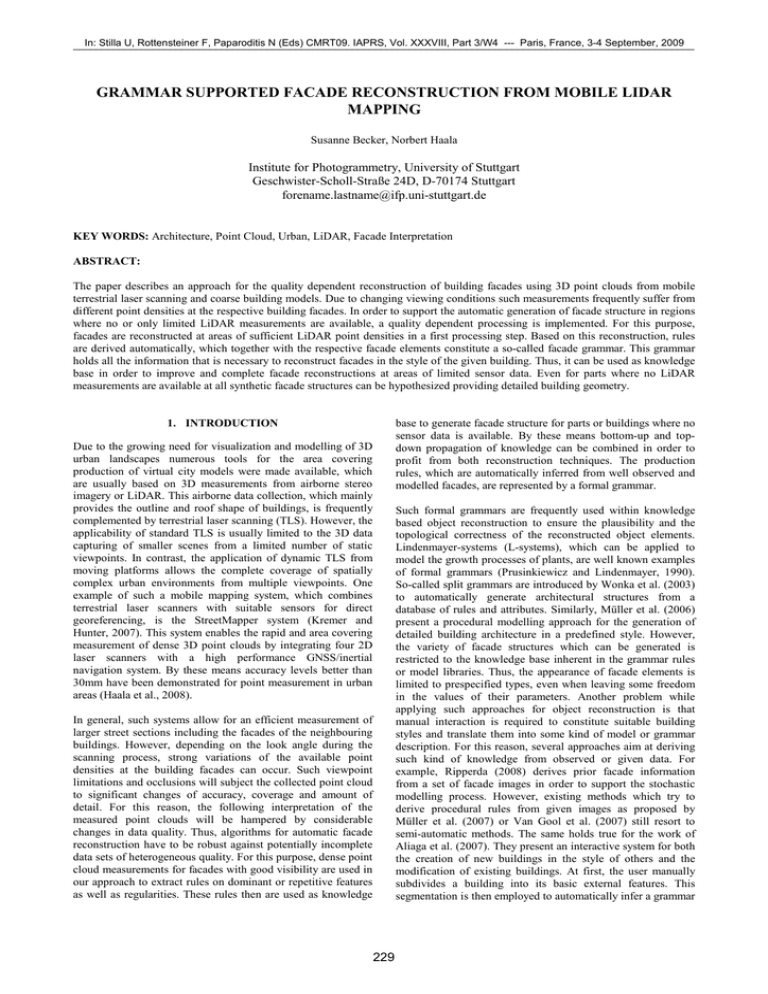
In: Stilla U, Rottensteiner F, Paparoditis N (Eds) CMRT09. IAPRS, Vol. XXXVIII, Part 3/W4 --- Paris, France, 3-4 September, 2009
¯¯¯¯¯¯¯¯¯¯¯¯¯¯¯¯¯¯¯¯¯¯¯¯¯¯¯¯¯¯¯¯¯¯¯¯¯¯¯¯¯¯¯¯¯¯¯¯¯¯¯¯¯¯¯¯¯¯¯¯¯¯¯¯¯¯¯¯¯¯¯¯¯¯¯¯¯¯¯¯¯¯¯¯¯¯¯¯¯¯¯¯¯¯¯¯¯¯¯¯¯¯¯¯¯¯¯¯¯
GRAMMAR SUPPORTED FACADE RECONSTRUCTION FROM MOBILE LIDAR
MAPPING
Susanne Becker, Norbert Haala
Institute for Photogrammetry, University of Stuttgart
Geschwister-Scholl-Straße 24D, D-70174 Stuttgart
forename.lastname@ifp.uni-stuttgart.de
KEY WORDS: Architecture, Point Cloud, Urban, LiDAR, Facade Interpretation
ABSTRACT:
The paper describes an approach for the quality dependent reconstruction of building facades using 3D point clouds from mobile
terrestrial laser scanning and coarse building models. Due to changing viewing conditions such measurements frequently suffer from
different point densities at the respective building facades. In order to support the automatic generation of facade structure in regions
where no or only limited LiDAR measurements are available, a quality dependent processing is implemented. For this purpose,
facades are reconstructed at areas of sufficient LiDAR point densities in a first processing step. Based on this reconstruction, rules
are derived automatically, which together with the respective facade elements constitute a so-called facade grammar. This grammar
holds all the information that is necessary to reconstruct facades in the style of the given building. Thus, it can be used as knowledge
base in order to improve and complete facade reconstructions at areas of limited sensor data. Even for parts where no LiDAR
measurements are available at all synthetic facade structures can be hypothesized providing detailed building geometry.
base to generate facade structure for parts or buildings where no
sensor data is available. By these means bottom-up and topdown propagation of knowledge can be combined in order to
profit from both reconstruction techniques. The production
rules, which are automatically inferred from well observed and
modelled facades, are represented by a formal grammar.
1. INTRODUCTION
Due to the growing need for visualization and modelling of 3D
urban landscapes numerous tools for the area covering
production of virtual city models were made available, which
are usually based on 3D measurements from airborne stereo
imagery or LiDAR. This airborne data collection, which mainly
provides the outline and roof shape of buildings, is frequently
complemented by terrestrial laser scanning (TLS). However, the
applicability of standard TLS is usually limited to the 3D data
capturing of smaller scenes from a limited number of static
viewpoints. In contrast, the application of dynamic TLS from
moving platforms allows the complete coverage of spatially
complex urban environments from multiple viewpoints. One
example of such a mobile mapping system, which combines
terrestrial laser scanners with suitable sensors for direct
georeferencing, is the StreetMapper system (Kremer and
Hunter, 2007). This system enables the rapid and area covering
measurement of dense 3D point clouds by integrating four 2D
laser scanners with a high performance GNSS/inertial
navigation system. By these means accuracy levels better than
30mm have been demonstrated for point measurement in urban
areas (Haala et al., 2008).
Such formal grammars are frequently used within knowledge
based object reconstruction to ensure the plausibility and the
topological correctness of the reconstructed object elements.
Lindenmayer-systems (L-systems), which can be applied to
model the growth processes of plants, are well known examples
of formal grammars (Prusinkiewicz and Lindenmayer, 1990).
So-called split grammars are introduced by Wonka et al. (2003)
to automatically generate architectural structures from a
database of rules and attributes. Similarly, Müller et al. (2006)
present a procedural modelling approach for the generation of
detailed building architecture in a predefined style. However,
the variety of facade structures which can be generated is
restricted to the knowledge base inherent in the grammar rules
or model libraries. Thus, the appearance of facade elements is
limited to prespecified types, even when leaving some freedom
in the values of their parameters. Another problem while
applying such approaches for object reconstruction is that
manual interaction is required to constitute suitable building
styles and translate them into some kind of model or grammar
description. For this reason, several approaches aim at deriving
such kind of knowledge from observed or given data. For
example, Ripperda (2008) derives prior facade information
from a set of facade images in order to support the stochastic
modelling process. However, existing methods which try to
derive procedural rules from given images as proposed by
Müller et al. (2007) or Van Gool et al. (2007) still resort to
semi-automatic methods. The same holds true for the work of
Aliaga et al. (2007). They present an interactive system for both
the creation of new buildings in the style of others and the
modification of existing buildings. At first, the user manually
subdivides a building into its basic external features. This
segmentation is then employed to automatically infer a grammar
In general, such systems allow for an efficient measurement of
larger street sections including the facades of the neighbouring
buildings. However, depending on the look angle during the
scanning process, strong variations of the available point
densities at the building facades can occur. Such viewpoint
limitations and occlusions will subject the collected point cloud
to significant changes of accuracy, coverage and amount of
detail. For this reason, the following interpretation of the
measured point clouds will be hampered by considerable
changes in data quality. Thus, algorithms for automatic facade
reconstruction have to be robust against potentially incomplete
data sets of heterogeneous quality. For this purpose, dense point
cloud measurements for facades with good visibility are used in
our approach to extract rules on dominant or repetitive features
as well as regularities. These rules then are used as knowledge
229
CMRT09: Object Extraction for 3D City Models, Road Databases and Traffic Monitoring - Concepts, Algorithms, and Evaluation
¯¯¯¯¯¯¯¯¯¯¯¯¯¯¯¯¯¯¯¯¯¯¯¯¯¯¯¯¯¯¯¯¯¯¯¯¯¯¯¯¯¯¯¯¯¯¯¯¯¯¯¯¯¯¯¯¯¯¯¯¯¯¯¯¯¯¯¯¯¯¯¯¯¯¯¯¯¯¯¯¯¯¯¯¯¯¯¯¯¯¯¯¯¯¯¯¯¯¯¯¯¯¯¯¯¯¯¯¯
Figure 3. This example is used in the following to illustrate our
bottom-up process for facade reconstruction. Within this
process, the geometric information inherent in the available
point cloud is exemplarily extracted for the facade marked by
the white polygon.
which captures the repetitive patterns and particularities of the
building. Finally, new buildings can be generated in the
architectural style defined by the derived grammar. Even though
this approach provides individually representative grammars
instead of predefined ones, the crucial part of the inference
process, the facade interpretation, has to be done manually. In
contrast we pursue an approach which runs fully automatically
during all processing steps.
The automatic generation of a facade grammar, which is derived
from 3D point cloud measurements of a mobile mapping
system, are discussed in section 2. As demonstrated in section 3
top-down predictions can be activated and used for the
improvement and completion of the reconstruction result that
has already been derived from the observed measurements
during the bottom-up modelling. Moreover, the facade grammar
can be applied to synthesize facades for which no sensor data is
available. The discussion of 3D reconstruction results
demonstrated in section 4 will conclude the paper.
2. GENERATION OF FACADE GRAMMAR
The automatic generation of a facade grammar based on
terrestrial LiDAR data is the core of our facade modelling
approach. The first step is a data driven reconstruction process
aiming at the detection of geometric facade structures in the
observed point clouds. In this regard, a facade defines a planar
polygon with holes. Such holes indicate either windows, which
will be modelled as indentations, or salient structures such as
balconies, oriels or windowsills, which will be attached in the
form of protrusions. The result of the data driven facade
reconstruction serves as knowledge base for the generation of
facade geometries where no sensor data is available. This
knowledge, which includes information on dominant or
repetitive structures as well as their interrelationships, can be
inferred fully automatically and stored as a facade grammar.
While data collection will be described as a pre-processing step
in section 2.1, the basic concepts of the data driven
reconstruction and the subsequent grammar inference will be
addressed in section 2.2 and 2.3, respectively.
Figure 1. 3D city model with overlaid trajectory from mobile
TLS
Figure 2. Point cloud from mobile TLS aligned with virtual city
model
2.1 Data Collection
The StreetMapper mobile laser scanning system which was
used for our experiments collects 3D point clouds at a full 360°
field of view by operating four 2D-laser scanners
simultaneously. The required direct georeferencing during 3D
point cloud collection is realized by the integration of
observations from GPS and Inertial Measurement Units (IMU).
Figure 1 shows a 3D visualisation of the measured trajectory
overlaid to the 3D city model which was also used for the
following tests. This 3D city model is maintained by the City
Surveying Office of Stuttgart. The roof geometry of the
respective buildings was modelled based on photogrammetric
stereo measurement while the walls trace back to given building
footprints. The trajectory was captured during our tests within
an area in the city centre of Stuttgart at a size of 1.5 km x 2km.
The respective point clouds were measured at a point spacing of
approximately 4cm. Figure 2 depicts a part of the StreetMapper
point cloud at the historic Schillerplatz in the pedestrian area of
Stuttgart. The observed points are overlaid to the corresponding
3D building models in order to show the quality and amount of
detail of the available data. Another measured point cloud
overlaid to an existing coarse building model is shown in
Figure 3. Lindenmuseum, Stuttgart: point cloud from TLS
aligned with existing coarse building model
230
In: Stilla U, Rottensteiner F, Paparoditis N (Eds) CMRT09. IAPRS, Vol. XXXVIII, Part 3/W4 --- Paris, France, 3-4 September, 2009
¯¯¯¯¯¯¯¯¯¯¯¯¯¯¯¯¯¯¯¯¯¯¯¯¯¯¯¯¯¯¯¯¯¯¯¯¯¯¯¯¯¯¯¯¯¯¯¯¯¯¯¯¯¯¯¯¯¯¯¯¯¯¯¯¯¯¯¯¯¯¯¯¯¯¯¯¯¯¯¯¯¯¯¯¯¯¯¯¯¯¯¯¯¯¯¯¯¯¯¯¯¯¯¯¯¯¯¯¯
edge points. Figure 4(right) shows the extracted edge points at
the window borders as well as the derived horizontal and
vertical lines. Based on these window lines, planar delimiters
can be generated for a subsequent spatial partitioning. Each
boundary line defines a partition plane which is perpendicular
to the facade. For the determination of the window depth, an
additional partition plane can be estimated from the LiDAR
points measured at the window crossbars. These points are
detected by searching a plane parallel to the facade, which is
shifted in its normal direction. The set of partition planes
provides the structural information for the cell decomposition
process. It is used to intersect the existing building model
producing a set of small non-overlapping 3D cells.
2.2 Data Driven Reconstruction
Frequently, the representation of buildings is based on
constructive solid geometry (CSG) or boundary representation
(B-Rep). In contrast, we apply a representation of the buildings
by cell decomposition (Haala et al., 2006). By these means,
problems which can occur during the generation of
topologically correct boundary representations can be avoided.
Additionally, the implementation of geometric constraints such
as meeting surfaces, parallelism and rectangularity is simplified.
Due to the applied representation scheme, the idea of our
reconstruction algorithm is to segment an existing coarse 3D
building object with a flat front face into 3D cells. Each 3D cell
represents either a homogeneous part of the facade or a window
area. Therefore, they have to be differentiated depending on the
availability of measured LiDAR points. After this classification
step, window cells are eliminated while the remaining facade
cells are glued together to generate the refined 3D building
model. These steps are depicted exemplarily within Figure 4
and Figure 5, and will be explained in the following sections.
The processing is based on the facade and point cloud marked
by the white polygon in Figure 3.
2.2.2 Classification and Reconstruction
In order to classify the 3D cells into facade and window cells, a
point-availability-map is generated. It is a binary image with
low resolution where each pixel defines a grid element on the
facade. The optimal grid size is a value a little higher than the
point sampling distance on the facade. Grid elements on the
facade where LiDAR points are available produce black pixels
(facade pixels), while white pixels (non-facade pixels) refer to
no-data areas. The classification is implemented by computing
the ratio of facade to non-facade pixels for each 3D cell. Cells
including more than 70% facade pixels are defined as facade
solids, whereas 3D cells with less than 10% facade pixels are
assumed to be window solids. While most of the 3D cells can
be classified reliably, the result is uncertain especially at
window borders or in areas with little point coverage. However,
the integration of neighbourhood relationships and constraints
concerning the simplicity of the resulting window objects
allows for a final classification of such uncertain cells. Figure
5(left) shows the classified 3D cells: facade cells (grey) and
window cells (white).
Figure 4. Lindenmuseum, Stuttgart: LiDAR point cloud (left),
and detected edge points and window lines (right)
Within a subsequent modelling process, the window cells are
cut out from the existing coarse building model. Thus, windows
and doors appear as indentations in the building facade which is
depicted in Figure 5(middle). Moreover, the reconstruction
approach is not limited to indentations. Details can also be
added as protrusions to the facade (Becker and Haala, 2007).
However, the achievable level of detail for 3D objects that are
derived from terrestrial laser scanning depends on the point
sampling distance. Small structures are either difficult to detect
or even not represented in the data. Nevertheless, by integrating
image data with a high resolution in the reconstruction process
the amount of detail can be increased (Becker and Haala, 2007).
This is exemplarily shown for the reconstruction of window
crossbars in Figure 5(right).
Figure 5. Lindenmuseum, Stuttgart: classified 3D cells (left),
3D facade model (middle), and refined 3D facade
model (right)
2.3 Automatic Inference of Facade Grammar
As it is already visible in Figure 3, the given scan configuration
resulted in considerable variations of the available point
coverage for the respective building. Thus, the bottom-up
facade reconstruction presented in the previous section was
realized for a facade, which is relatively well observed. This
overall result is now used to infer the facade grammar.
Frequently, such formal grammars are applied during object
reconstruction to ensure the plausibility and the topological
correctness of the reconstructed elements (Müller et al., 2006).
In our application, a formal grammar will be used for the
generation of facade structure where only partially or no sensor
data is available.
2.2.1 Point Cloud Segmentation
At glass LiDAR pulses are either reflected or the glass is
penetrated. Thus, as it can be seen in Figure 4(left), by laser
scanning usually no points are measured in the facade plane at
window areas. If only the points are considered that lie on or in
front of the facade, the windows will describe areas with no
point measurements. These no-data areas can be used for the
point cloud segmentation which aims at the detection of
window edges. For example, the edge points of a left window
border are detected if no neighbour measurements to their right
side can be found in a predefined search radius. In a next step,
horizontal and vertical lines are estimated from non-isolated
231
CMRT09: Object Extraction for 3D City Models, Road Databases and Traffic Monitoring - Concepts, Algorithms, and Evaluation
¯¯¯¯¯¯¯¯¯¯¯¯¯¯¯¯¯¯¯¯¯¯¯¯¯¯¯¯¯¯¯¯¯¯¯¯¯¯¯¯¯¯¯¯¯¯¯¯¯¯¯¯¯¯¯¯¯¯¯¯¯¯¯¯¯¯¯¯¯¯¯¯¯¯¯¯¯¯¯¯¯¯¯¯¯¯¯¯¯¯¯¯¯¯¯¯¯¯¯¯¯¯¯¯¯¯¯¯¯
a)
In principle, formal grammars provide a vocabulary and a set of
production or replacement rules. The vocabulary comprises
symbols of various types. The symbols are called non-terminals
if they can be replaced by other symbols, and terminals
otherwise. The non-terminal symbol which defines the starting
point for all replacements is the axiom. The grammar’s
properties mainly depend on the definition of its production
rules. They can be, for example, deterministic or stochastic,
parametric and context-sensitive. A common notation for
productions which we will refer to in the following sections is
given by
id :
lc < pred > rc : cond
→
b) floor 1 → w1 g1 w3 g1 w1 g1 w3 g1 w1 g1 w3 g1 w1 g1 w3 g1 …
w2 g1 w3 g1 w2 g1 w3 g1 w1 g1 w3 g1 w1 g1 w3 g1 w1 g1 w3 g1 w1
c) floor 1 → w1 S3 w2 S1 w2 S3 w1
S1 → g1 w3 g1
S2 → S1 w1 S1
S3 → S2 w1 S2
d)
succ : prob
The production identified by the label id specifies the
substitution of the predecessor pred for the successor succ.
Since the predecessor considers its left and right context, lc and
rc, the rule gets context-sensitive. If the condition cond
evaluates to true, the replacement is carried out with the
probability prob. Based on these definitions and notations, we
develop a facade grammar Γfacade(N,T,P,ω) which allows us to
synthesize new facades of various extents and shapes. The
axiom ω refers to the new facade to be modelled and, thus,
holds information on the facade polygon. The sets of terminals
and non-terminals, T and N, as well as the production rules P
are automatically inferred from the reconstructed facade as
obtained by the data driven reconstruction process (section 2.2).
Figure 6. Modelled floor (a), corresponding tile string (b),
compressed tile string and extracted structures (c),
parse tree (d)
2.3.3 Inference of Production Rules
Based on the sets of terminals T={w1, w2, … , g1, g2, …} and
non-terminals N={W, G, … , S1, S2, …}, which have been set up
previously, the production rules for our facade grammar can be
inferred. Following types of production rules are obtained
during the inference process:
2.3.1 Searching for Terminals
In order to yield a meaningful set of terminals for the facade
grammar, the building facade is broken down into some set of
elementary parts, which are regarded as indivisible and
therefore serve as terminals. For this purpose, a spatial
partitioning process is applied which segments the facade into
floors and each floor into tiles. Tiles are created by splitting the
floors along the vertical delimiters of geometries. A geometry
describes a basic object on the facade that has been generated
during the data driven reconstruction process (section 2.2). It
represents either an indentation like a window or a protrusion
like a balcony or an oriel. Two main types of tiles can be
distinguished: wall tiles, which represent blank wall elements,
and geometry tiles, which include structures like windows and
doors. All these tiles are used as terminals within our facade
grammar. In the remaining sections of the paper, wall tiles will
be denoted by the symbols W for non-terminals and wi for
terminals. Geometry tiles will be referred to as G and gi in case
of non-terminals and terminals, respectively.
p1: F → W+
p2: W : cond → W G W
p3: G : cond → Si : P(x|p3)
p4: G : cond → gi : P(x|p4)
p5: lc < W > rc : cond → wi : P(x|p5)
The production rules p1 and p2 stem from the spatial
partitioning of the facade. p1 corresponds to the horizontal
segmentation of the facade into a set of floors. The vertical
partitioning into tiles is reflected in rule p2. A wall tile, which in
the first instance can stand for a whole floor, is replaced by the
sequence wall tile, geometry tile, wall tile. Each detected
structure gives rise to a particular production rule in the form of
p3. This rule type states the substitution of a geometry tile for a
structure Si. In addition, all terminal symbols generate
production rules denoted by p4 and p5 in the case of geometry
terminals gi and wall terminals wi, respectively. A more detailed
description of all rule types pi and the probabilities P(x|pi)
assigned to them can be found in Becker et al. (2008).
2.3.2 Interrelationship between Terminals
Having distinguished elementary parts of the facade we now
aim at giving further structure to the perceived basic tiles by
grouping them into higher-order structures. This is done fully
automatically by identifying hierarchical structures in sequences
of discrete symbols. The structural inference reveals
hierarchical interrelationships between the symbols in terms of
rewrite rules. These rules identify phrases that occur more than
once in the string. Thus, redundancy due to repetition can be
detected and eliminated. For more information on this process
please refer to Becker et al. (2008). As an example, Figure 6a
shows a modelled floor. While Figure 6b depicts the
corresponding tile string in its original version, the compressed
string and the extracted structures are given in Figure 6c. The
hierarchical relations between the facade elements can be stored
in a parse tree illustrated in Figure 6d.
3. APPLICATION OF FACADE GRAMMAR
Our facade grammar derived in the previous section implies
information on the architectural configuration of the observed
facade concerning its basic facade elements and their
interrelationships. Based on this knowledge facade hypotheses
can be generated as described in section 3.1. Section 3.2
presents different application scenarios. Facades and building
parts which are covered by noisy or incomplete sensor data are
usually subject to inaccurate and false reconstructions which are
due to problems of the data driven reconstruction process. For
such regions possible facade geometry can be proposed in order
to improve and complete facade structures. Furthermore, the
production process can also be used to synthesize totally
unobserved building objects.
232
In: Stilla U, Rottensteiner F, Paparoditis N (Eds) CMRT09. IAPRS, Vol. XXXVIII, Part 3/W4 --- Paris, France, 3-4 September, 2009
¯¯¯¯¯¯¯¯¯¯¯¯¯¯¯¯¯¯¯¯¯¯¯¯¯¯¯¯¯¯¯¯¯¯¯¯¯¯¯¯¯¯¯¯¯¯¯¯¯¯¯¯¯¯¯¯¯¯¯¯¯¯¯¯¯¯¯¯¯¯¯¯¯¯¯¯¯¯¯¯¯¯¯¯¯¯¯¯¯¯¯¯¯¯¯¯¯¯¯¯¯¯¯¯¯¯¯¯¯
side facing scanners are blue (right scanner) and red (left
scanner).
3.1 Production of Facade Hypothesis
The production process starts with an arbitrary facade, called
the axiom, and proceeds as follows: (1) Select a non-terminal in
the current string, (2) choose a production rule with this nonterminal as predecessor, (3) replace the non-terminal with the
rule’s successor, (4) terminate the production process if all nonterminals are substituted, otherwise continue with step (1). The
geometrical result of the production process depends on the
order in which the non-terminals are selected. Usually, best
results are obtained when facade structures which are likely to
appear in the middle of the facade are placed first, and the
remaining spaces to the left and the right side are filled
afterwards. As it is illustrated in Figure 7, the non-terminal
selection refers to this principle. For clearness, we here assume
a facade with only one floor. In each step, the non-terminal
selected for the next substitution is marked in red.
Figure 8. Measured facade points and determined convex
‘dense area’ (blue rectangle)
As it is visible in Figure 8, the point sampling distance varies
strongly due to occlusions and oblique scanning views to the
upper part of the building. For this reason, facades may contain
areas where no or only little sensor data is available. In such
regions, an accurate extraction of windows and doors cannot be
guaranteed anymore. Nevertheless, a grammar based facade
completion allows for meaningful reconstructions even in those
areas. The main idea is to derive the facade grammar solely
from facade parts for which dense sensor data and thus accurate
window and door reconstructions are available. The detection
of such ‘dense areas’ is based on a heuristic approach
evaluating the sampling distances of the points lying on the
facade surface. In Figure 8 the extracted convex dense area is
marked by a blue rectangle. Since the inference process is
restricted to this dense area, a facade grammar of good quality
can be provided, which is then used to synthesize the remaining
facade regions during the production step.
Figure 7. Non-terminal selection
As long as the facade string consists of only one symbol, the
non-terminal selection is trivial. In the third line, substitution
starts with the non-terminal G in the middle of the string. According to this replacement, the chosen geometry tile gi will be
placed about in the middle of the facade floor. The following
replacements are taken from the left to the right of the string.
When there is only one non-terminal left on the right end of the
string (see the last line in Figure 7), the left part of the facade
floor is completely filled with a sequence of wall and geometry
tiles. At this stage, symmetry can be enforced by substituting
the remaining non-terminal W by a mirrored version of the left
terminal string. If no symmetry is required, the replacement can
be continued as described before. During the production, nonterminals are successively rewritten by the application of
appropriate production rules. When more than one production
rule is possible for the replacement of the current non-terminal,
the rule with the highest probability value is chosen. As soon as
the facade string contains only terminals, the production is
completed and the string can be transferred into a 3D
representation.
Figure 9. Facade reconstruction for the “Lindenmuseum”
3.2 Application Scenarios
Within the production process, the grammar is applied to
generate hypotheses about possible positions of each geometry
tile and thereby synthesize facade geometry for given coarse
building models. This process can for example be used to
generate facade structure at areas, where sensor data is only
available at limited quality. Such a scenario is depicted
exemplarily in Figure 8, which shows a StreetMapper point
cloud for an exemplary facade acquired during two epochs. The
colours encode the different scanners mounted on the
StreetMapper. Points that stem from the upward facing laser
scanner are marked in yellow; points that are measured by the
Figure 10. Facade geometry synthesized from grammar library
233
CMRT09: Object Extraction for 3D City Models, Road Databases and Traffic Monitoring - Concepts, Algorithms, and Evaluation
¯¯¯¯¯¯¯¯¯¯¯¯¯¯¯¯¯¯¯¯¯¯¯¯¯¯¯¯¯¯¯¯¯¯¯¯¯¯¯¯¯¯¯¯¯¯¯¯¯¯¯¯¯¯¯¯¯¯¯¯¯¯¯¯¯¯¯¯¯¯¯¯¯¯¯¯¯¯¯¯¯¯¯¯¯¯¯¯¯¯¯¯¯¯¯¯¯¯¯¯¯¯¯¯¯¯¯¯¯
As an example, this process is depicted in Figure 9 for
Stuttgart’s Lindenmuseum which has already been illustrated in
Figure 3. There, the original coarse model is shown in
combination with the overlaid 3D point cloud whereas Figure 9
demonstrates the reconstructed facade geometry. The blue
shaded region corresponds to the white polygon in Figure 3 and
indicates the facade geometry that has been generated during
the data driven reconstruction process. All remaining building
parts are modelled based on the grammar inferred from the
marked region.
5. REFERENCES
Aliaga, D., Rosen, P., Bekins, D., 2007. Style Grammars for
Interactive Visualization of Architecture. IEEE TVCG 13 (4).
Becker, S., Haala, N., 2007. Refinement of Building Facades by
Integrated Processing of LIDAR and Image Data. IAPRS & SIS
Vol. 36 (3/W49A), pp. 7-12.
Becker, S., Haala, N., Fritsch, D., 2008. Combined Knowledge
Propagation for Facade Reconstruction. IAPRS & SIS Vol. 37
(B5), pp. 1682-1750.
While in that example the grammar is applied for the
completion of facade structure, it can also be used as a “library”
to generate building facades for objects, where no measurement
is available at all. This step is demonstrated in Figure 10 where
facade geometry was synthesized for a number of residential
houses. Since these building were not covered by any sensor
data at all, a range of grammars was derived in advance from a
few buildings in the near environment. Similarly, the
applicability of our facade grammars to a larger scene using
grammars which represent compatible architectural styles is
shown in Figure 11.
Haala, N., Becker, S., Kada, M., 2006. Cell Decomposition for
the Generation of Building Models at Multiple Scales. IAPRS
Vol. 36 (3), pp. 19-24.
Haala, N., Peter, M., Kremer, J., Hunter, G., 2008. Mobile
LiDAR Mapping for 3D Point Cloud Collection in Urban Areas
- a Performance Test. IAPRS, Vol. 37, (B5), pp. 1119f.
Kremer, J., Hunter, G., 2007. Performance of the StreetMapper
Mobile LIDAR Mapping System in “Real World” Projects.
Photogrammetric Week '07, pp. 215-225.
4. DISCUSSION
Müller, P., Wonka, P., Haegler, S., Ulmer, A., Van Gool, L.,
2006. Procedural Modeling of Buildings. ACM Transactions on
Graphics (TOG) 25 (3), pp 614-623.
Within the paper an automatic approach for the geometric
modelling of 3D building facades was proposed. Based on
observed 3D point clouds from a mobile mapping system,
grammar rules are extracted, which can then be used to generate
synthetic facade structures for unobserved building parts.
Despite the good geometric accuracy which is feasible for
terrestrial point clouds such data frequently suffer from the
unavailability of measurements for hidden building parts. This
problem is solved by extracting the grammar from observed
street-facing facades and then applying it for the improvement
and completion of remaining facade structure in the style of the
respective building. Moreover, knowledge propagation is not
restricted to facades of one single building. Based on a small set
of facade grammars derived from just a few observed buildings,
facade reconstruction is also possible for whole districts
featuring uniform architectural styles. Due to these reasons the
proposed algorithm is very flexible towards different data
quality and incomplete sensor data.
Müller, P., Zeng, G., Wonka, P., Van Gool, L., 2007. Imagebased Procedural Modeling of Facades. ACM Transactions on
Graphics (TOG) 26 (3), article 85, 9 pages.
Prusinkiewicz, P., Lindenmayer, A., 1990. The algorithmic
beauty of plants. New York, NY: Springer.
Ripperda, N., 2008. Determination of Facade Attributes for
Facade Reconstruction. IAPRS & SIS Vol. 37 (B3a), 6 pages.
Van Gool, L., Zeng, G., Van den Borre, F., Müller, P., 2007.
Towards mass-produced building models. IAPRS & SIS, Vol.
36 (3/W49A), pp. 209–220.
Wonka, P., Wimmer, M., Sillion, F., Ribarsky, W., 2003.
Instant architecture. ACM TOG 22 (3), pp. 669–677.
Figure 11. Facade geometry for larger area
234

